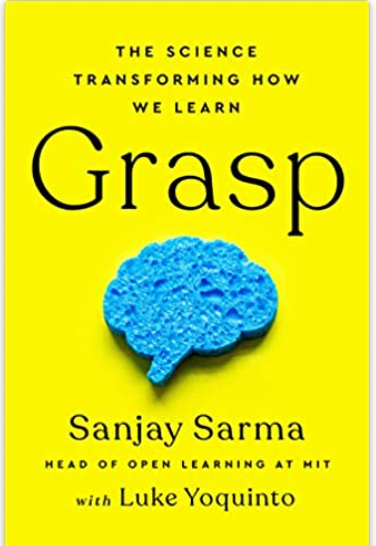
Guest post by Douglas W. Green, EdD
Blog: https://DrDougGreen.com
Twitter: @DrDougGreen
Introduction
Grasp: The Science of Transforming How We Learn by Sanjay Sarma with Luke Yoquinto tells the story of teaching and learning during the last hundred plus years. They explain what works and what doesn’t. They make it clear that learning should be spaced rather than crammed at the last minute, that different concepts should be interleaved, and that the effort one uses to retrieve memories helps reinforce them.
While we need to teach hard facts, we also need to let students use their hands to wield them. This book is a must-read for teachers and learners alike and would make a great textbook for an introductory education course.
Spacing & Recall
It is well established that spacing out your study on a topic, rather than cramming it all at once prior to an exam leads to more retention. This is even true for invertebrates without brains. Repetition creates more connections between neurons giving memories more synaptic strength. Also, the concept of interleaving suggests that while you are putting space between learning efforts on the same content, you should work on learning other subjects.
Corporations seem to know this better than schools. This is due to the fact that their employees must understand the key concepts or their business is likely to fail. Low-stakes quizzes that continually call back earlier material promote efficient learning
Studies show that the brain is much more capable of storing things in long-term memory when it is curious. Skimming material prior to reading it in earnest can set up questions that only a careful perusal will answer. While we need a wider tolerance for diverse student motivations and interests (outside-in), we also need to teach useful, hard knowledge (inside-out).
Over learn the Important Stuff
We need to do over-learning for some material like math facts so they can be summoned during problem-solving with little effort. While you can find just about anything while searching the Internet, you are not likely to get much accomplished if you are constantly searching for information that you could otherwise easily retrieve from long-term memory.
Effortful retrieval adds to storage strength. There doesn’t appear to be any practical limit on the brain’s storage capacity, but we can only retrieve so much at once.
The idea of interleaving states that we should go from one thing to another and come back several times rather than focusing too long on one thing. This process creates more desirable difficulty. Since you are working on something that you worked on a while ago, your retrieval is more effortful and therefore more effective.
Flipping Your Class
Lectures are known for being rather ineffective when it comes to transferring knowledge. At this writing at least half of college professors in the U.S. expect students to read the material or watch videos prior to coming to class to discuss or actively use what they have studied.
It is vital that students somehow put their hands-on knowledge and concepts they have read about. As they discuss content with each other and their teachers, they will essentially teach the content to others and internalize it themselves. This is why collaboration is necessary.
Students should grade students who are at lower levels thus revisiting earlier lessons and strengthening their memory of the content. It is important that everyone is a teacher as teaching something is the best way to really learn it.
This can also lead to a form of mastery learning where you don’t move on until you prove you know the prerequisites. Out of necessity, this approach is also self-paced. Discussing content that is new to all students is fine. Content that has already been presented, however, shouldn’t be presented again to all students at the same time.
The best subject for totally self-paced learning is probably math. I’ve seen many classes where students use software to learn and practice math skills at their own pace with teacher assistance. When this happens it’s amazing how fast some students move while other students take all the time they need prior to forging ahead avoiding frustration.
Conclusion
It is vital that teachers get students to space out their learning. This can be done in class by revisiting important material several times prior to the end of a unit. Teachers can also explain to their students how doing so outside of class is in their best interests.
Rather than just giving unit tests, midterms, and finals, there have to be frequent low/no-stakes opportunities for students to engage in recall as recalling something does more to strengthen memories than additional study.
Telling big picture stories prior to dealing with details can instill curiosity, which is a powerful motivator. This is one reason why students need some opportunity to follow their own interests.
Since teacher talk (lectures) are highly ineffective, students should read and watch videos prior to discussing and working hands-on with concepts. They should also be able to work at their own pace and test each other to further revisit material. They should work at their own pace when possible and not move on until they master the content they will need in future lessons.
As you implement the ideas present here, grab a copy of the book that inspired this article. You can also read my full summary at https://bit.ly/37pvppd.

Comments